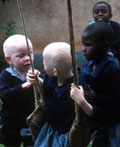
|
|
Common Causes of Low Vision, Blindness and Vision Impairment
Some diseases which cause corneal damage are:
Neonatal Conjunctivitis (Ophthalmia Neonatorum)
Severe conjunctivitis that appears in the first week of life. Serious damage to vision occurs if it is not treated immediately. The eyes must be cleansed and drops or ointment given.Xerophthalmia
Caused by Vitamin A deficiency. It starts with the drying of the conjunctiva and cornea. The retina is also affected causing poor vision in dull light and at night. Xerophthalmia is caused by poor diet - a lack of dark green leafy vegetables, yellow vegetables, tubers and fruits, eggs and milk. Treatment can be given by one or more doses of vitamin A. The condition can be present and then disappear during different seasons because of the fruits and vegetables that are available. If the condition is allowed to progress, the cornea becomes cloudy and is eventually destroyed. A child with xerophthalmia may have poor general health.Measles and xerophthalmia are a dangerous combination and can rapidly cause corneal ulceration (keratomalacia) and blindness. The use of harmful eye medicines to treat conjunctivitis during measles can damage the cornea and lead to low vision or blindness.
Cataract is a clouding of all or part of the lens. Usually visual acuity is reduced and vision is blurred and depth perception can be affected. The effect on vision depends on the area and cloudiness of the cataract.
The amount and direction of light affects people with cataracts. Vision can change depending on the light. Glare causes discomfort and makes vision worse. Outside, a person would be better working in the shade if this is possible, or wearing a hat to shade the eyes. Inside, the person should face away from the light coming from a window or door.
Near or distance vision or both may be affected. Materials and objects of good contrast are better for a person with cataracts. Large print or increase in size of materials may not be necessary. The most important needs are for good lighting without glare and good contrast.
A cataract can be present at birth. It can develop later in life from injury, illness, a lifetime of sunlight exposure or in old age. Some cataracts don't change but others become worse. Blindness can result.
The treatment for cataract is the surgical removal of the lens. This needs a specially trained person to do the operation. Glasses or special lenses are needed to take the place of the lens that has been removed.
Glaucoma
Glaucoma is a disease of the nerves (retina/optic nerve) that can occur with either 'normal' or high pressure in the eye. Peripheral visual fields become reduced and visual acuity is affected. Vision is affected in dull light and at night so good lighting is needed. Sometimes drops or an operation are needed to help control the pressure in the eyes. If drops are prescribed they should be used regularly. Blindness can result if it is not treated.Many eye diseases such as glaucoma run in families.
Rubella
Congenial Rubella Syndrome occurs in babies whose mothers have been infected by rubella (German measles) during pregnancy. Congenital Rubella Syndrome results in multiple disabilities including cataracts, glaucoma, deafness and heart disease.Retinal Dystrophies
There are a large number of conditions where the retina and especially the macula never develop properly or are destroyed (degeneration). Age-related macular degeneration (AMD) can have onset in childhood but more commonly occurs in older people. Both near and distance vision are affected when the central area of the retina is involved. Making objects or print larger will help make things easier to see. Low vision devices are often helpful.More information on Low Vision Devices
Retinitis pigmentosa
This usually affects young adults. There is a slow worsening of vision. The peripheral (side) vision is the first area affected. Visual acuity may remain normal or become poor. In good light the person may be able to do many activities that require good vision. Vision is often poor in dull light or at night. It can be difficult to move around safely and avoid objects.Optic Atrophy
This is a degeneration of the optic nerves caused by injury to the eye, glaucoma, poisons, congenital (present at birth) defects and difficulties at birth. Visual acuity is affected and sometimes parts of the visual field are missing. Good lighting is usually needed for better visual functioning. Low vision devices and large print may be helpful.More information on Low Vision Devices
Nystagmus
Nystagmus is a movement of the eyes which cannot be controlled or stopped. Usually the movements are small and from side to side but movements in other directions also occur. Nystagmus usually occurs when an eye condition has been present from birth. Vision may be blurred but the person does not see the world as moving. Near vision is usually better than distance vision. Nystagmus cannot be treated. There may also be an unusual head posture or shaking or nodding of the head.Refractive Errors
As discussed in "The Visual System"
Onchocerciasis

The nodule on this child's head is filled with filarial worms
Onchocerciasis (River Blindness) is caused by a filarial worm which enters the body. It can result in corneal and chorio-retinal scarring. Vision is also impaired from inflammation within the eye and from cataracts, glaucoma and optic atrophy which can also develop. A new drug, Ivermectin, is being given to people in areas where onchocerciasis occurs. It is used to stop the progression of eye (and skin) damage caused by millions of tiny worms.
Trauma
Accidents to the eye. Often vision is impaired in only one eye in accidents but sometimes both eyes can be affected. Injuries to the surface of the eye (conjunctiva or cornea) are common. Immediate treatment of an eye injury is essential to prevent blindness. Vision loss can also occur after an injury to the head.Harmful Eye Practices
Harmful eye practices used by traditional healers or untrained people can result in low vision and blindness. Hot objects, fluids and solids (such as extracts from plants, human or animal body fluids) applied to the eye can cause serious damage to the eye.Describe albinism - how is the eye affected?
|
|
| Visual Communication Unit |




